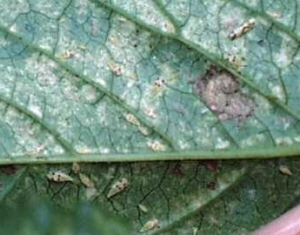Grape Leafhoppers
 Scientific Name
Scientific Name
Erythroneura comes
Host
All stages of this insect feed on grape, Virginia creeper, apple and several other plants.
Symptoms
Leafhoppers feed by inserting their piercing-sucking mouth-parts into the plant to remove fluids from the tissue. Feeding by this insect causes the leaves and fruit to appear stippled with very tiny white spots. Eventually, these spots turn brown and may cause the leaves and fruit to shrivel. The leaves may become pale yellow in color and assume a very sickly appearance. Nymphs and flying adults may be noticeable on the undersides of leaves.
Life Cycle
This species of leafhopper overwinters as an adult in leaf litter, grasses or other wherever they can find shelter near the vineyard. After feeding for about two weeks after emerging, the females begin laying eggs in leaf tissue. Eggs generally hatch in about 10 to 20 days depending on temperature. Nymphs reach maturity in 3 to 5 weeks, also depending on temperature. There are three generations per year in Oklahoma.
Description
Adult grape leafhoppers are pale yellow, with red markings on the wings. These markings can give this leafhopper a somewhat mottled appearance. They are about 1/8 of an inch in length and somewhat wedge-shaped. Immature forms are pale green or greenish-white and lack the markings and wings of the adult. This insect first becomes active about the time that grape leaves are half-extended. The eggs are inserted into the leaf tissue by the female, which can deposit about 100 eggs.
Control
Please contact your local county extension office for current information.
